
Privacy statement: Your privacy is very important to Us. Our company promises not to disclose your personal information to any external company with out your explicit permission.

We all know that LED is a semiconductor light-emitting device, and semiconductor is a heat-sensitive device, which means that it is very sensitive to temperature. Or temperature will directly affect its performance and parameters. As an electro-optical conversion device, its most important indicator is how many watts of electric power is input, and how much luminous flux (lumen) is output. We call it luminous efficiency (luminous efficiency), which represents the most important quality indicator of LED. The user also selects the LED with the smallest wattage according to the luminous flux (the number of lumens) he needs.
However, although the LED device itself has a light effect, it does not mean that the user can directly enjoy the light effect, because assembling the LED device into a lamp will lose some of the light effect. We do not consider the light transmittance of the reticle (assuming 100%, in fact, usually around 90%), but mainly consider the light efficiency of the LED light source itself. We also have two kinds of light effects: cold light effect and hot light effect. Perhaps most people will not pay attention to the difference between the two light effects, so we have to discuss the cold light effect and the thermal light effect here first.
1. What is cold light effect? What is hot light effect?
Simply speaking, the cold light effect is the light effect measured when the LED light source is at room temperature (25 ° C), and the thermal light effect is the light effect measured after the LED light source is thermally stabilized. Specifically, we usually use the integrating sphere to measure the light efficiency of the LED light source, then the light effect measured immediately after the power is turned on is the cold light effect (assuming that the room temperature is 25 degrees at that time), this "immediately" is about 5 Within seconds. The thermal efficacy is at least half an hour to three quarters of an hour to reach thermal equilibrium (or thermal stability). Nowadays, the light effect we usually say is cold light effect, or most of the light efficiency indicators that we usually indicate on the outer casing or outer packaging are cold light effect.
For the vast majority of users, what they care about is actually hot light. Because LED lighting will be used for more than half an hour, unfortunately, the user only knows the cold light effect of this light fixture and does not know the thermal efficacy of this light. In a sense, this is an unintentional trick. Consumer behavior.
In any case, I suggest that in the future, the thermal efficacy should be used as a light effect indicator, marked on the box.
2. What is the difference between cold light effect and hot light effect?
Let's take a look at how much difference between cold light effect and hot light effect. In order to understand the difference between the hot and cold light effects of the LED lamps of various well-known brands, we went to the United States and Japan to purchase several well-known brand LEDPAR lamps for actual testing. The results are shown in the following table:

The starting value is measured immediately after the power is turned on, and the final value refers to the test value after waiting for half an hour.
For example, the output lumen of Philips' 432195 bulb has been reduced from 1860 lm to 1680 lm to 92% after half an hour. The specific lumen reduction process is shown in the figure below.
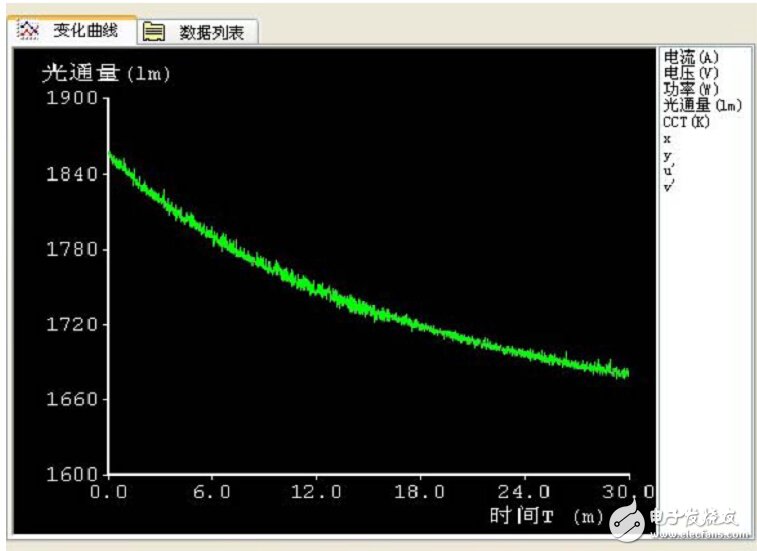
In fact, it has not yet reached the stable value for half an hour, and it may take three quarters or an hour to be truly stable.
From the above table, the following conclusions can be drawn:
(1) The luminous efficacy start and end values of all brands of LED lamps are different.
(2) The difference is at least 0.97 and the maximum is 0.86
(3) The difference in input power is actually independent of the thermal characteristics of the LED.
(4) The difference in light efficiency is mainly due to the increase in junction temperature of the LED.
(5) The increase in junction temperature is unavoidable, because the efficiency of the LED itself is only about 40%, and the others are converted into heat, so the heat gradually increases after power-on, and finally rises from room temperature to heat stability. However, the magnitude of the rise is related to the quality of the heat sink. The better the heat sink, the lower the temperature rise. Therefore, in order to reduce the difference between the thermal efficacy and the cold light effect, a good heat sink should be used as much as possible.
3. LED light engine's hot and cold light effect
Why do we especially study the thermal and thermal effects of LED light engines? This is because light engines have their own special features. The so-called light engine actually puts the LED power supply on the aluminum substrate where the LED light source is located. As a result, the power consumed by the LED power supply is also released on the aluminum substrate, which increases the heat to be dissipated by the aluminum substrate. This will increase the junction temperature of the LED after thermal stabilization. Here is an example to illustrate that the most common type of electroless capacitive light engine currently on the market is usually only about 85%, which means that 15% of the input power is converted to heat. On the aluminum substrate. Assuming a total input power of 10 watts, the remaining 8.5 W is added to the LED, assuming that the LED itself has a luminous efficiency of 40%, that is, only 3.4 W of power is converted to useful light, and 5.1 W of power becomes hot. Originally, the aluminum substrate only needs to dissipate this 5.1W of heat, and now it is necessary to add 15% of the power, that is, 1.5W of heat. A total of 6.6W of heat is needed, which increases the heat of 29.4%, which is close to 30%. The thermal resistance of the aluminum substrate does not change. The increase in power means that the temperature rises, and the temperature of the aluminum substrate rises, which means that the ambient temperature of the LED on the same aluminum substrate increases, and the junction temperature also rises. The result is a reduction in light efficiency.
4. Actual test results of LED light engine cold light effect and thermal light effect
We tested a 60W electroless capacitive light engine from a Shenzhen company and a 60W electrolytic capacitor light engine from Efira. The photo of the two is as follows:
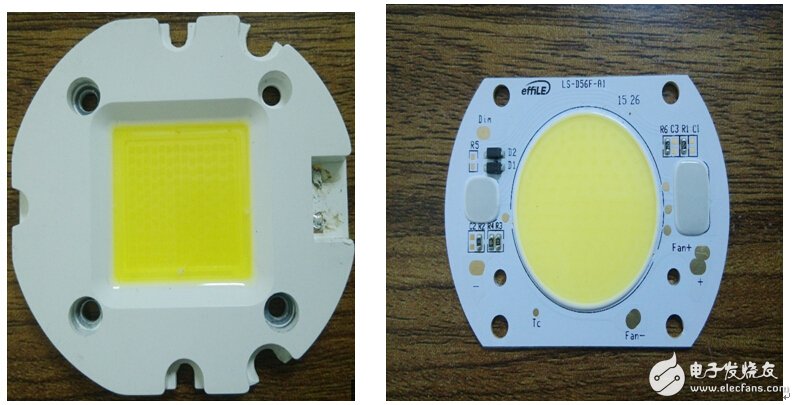
Shenzhen company a non-electrolytic capacitor 60W light engine Effie has an electrolytic capacitor 60W light engine
The same heat sink was used in the test to avoid the difference in heat dissipation between the two. The results of the total luminous flux of these two light engines over time are as follows:

A company's electroless capacitor light engine luminous flux Effie's electrolytic capacitor light engine luminous flux
The total luminous flux of the former dropped from 5780lm, which was just turned on, to 5120lm after half an hour, about 11.4%, and from the downward trend, it should be further reduced to 5000lm over time. The luminous flux of Effie's light engine dropped from 7233.8lm to 6486.8lm.
The input power curve of the two is shown in the figure below:
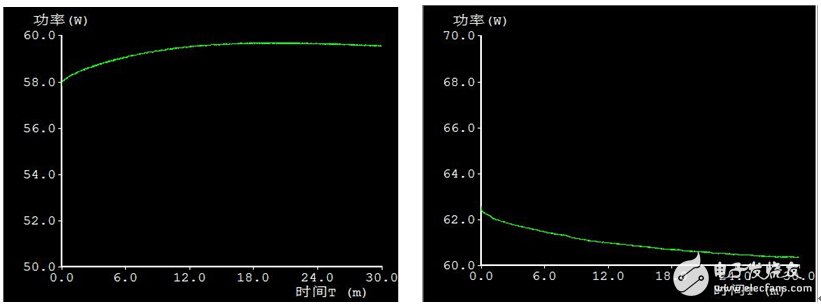
Shenzhen company 60W light engine electric power changes Effie company 60W light engine electric power changes
The light engine of a company in Shenzhen has also adopted power compensation (see above), and its input power has risen from 57.81W to 59.53W in 30 minutes. So its light efficiency is reduced from 100lm/W to 86lm/W, a 14% reduction. If the final stable thermal flux is 5000 lm, its final luminous efficacy is only 84 lm / W, a decrease of 16%. And its nominal luminous efficacy is 100lm / W, if it is still achieved from the cold light effect, but if it is from the thermal light effect, it is 16% worse.
And Effie Opto's 60W electrolytic capacitor light engine, its power dropped from 62.53W to 60.354W in 30 minutes (closer to the rated value of 60W), so its light efficiency from the beginning of 115.68lm / W, It dropped to 107.48 lm/W, only down 7.1%, which is similar to the range of general lighting. This is equivalent to a drop in the normal light efficiency caused by the junction temperature of the LED rising from a room temperature of 25 degrees to a junction temperature of about 85 degrees of the designed rating. This is because Effie's constant current source efficiency is as high as 99%. Therefore, integrating such a highly efficient constant current source on an aluminum substrate does not increase the junction temperature of the LED after thermal stabilization. Therefore, the difference between cold light effect and thermo-optic effect is still within the range of normal values.
By the way, the difference between the two light engines we compare here is not caused by the different light effects of the LED itself. The LED used by the former's electroless capacitive light engine is a large chip 3535. The area is 1225mil2, and the Effie's optical engine with electrolytic capacitors uses 3518 LEDs, which are only 630mil2, with a difference of up to 595mil2, and the former is larger. The absolute value of Effie's thermal efficacy is as high as 107.48 lm / W, far more than 25% higher than the company's 86 lm / W.
5. Differences between various electroless capacitive light engines
Although we only measured the difference between the heat and the light effect of a certain company or a certain product. Some people may suggest that this is a point-to-face, not comprehensive opinion. This is true if the accuracy of the data is true, but if the results of the data are used, the results are very representative. In fact, the reason is very simple, the main reason for the difference between the hot and cold light effect is because the low-efficiency constant current source is integrated on the aluminum substrate with the light source, which results in the junction temperature of the LED compared to the junction without the constant current source. The temperature is high, so its thermal efficacy will be low. For the switching power supply, its efficiency is likely to reach 95%, but due to the large number of switching power supply components, large size, it is impossible to integrate on the aluminum substrate. So all of the current integration into the aluminum substrate can only be a linear power supply. Of course, there are also many types of linear power supplies. The most widely used ones are the electroless capacitive light engines that are segmented and lit, and the light engines with electrolytic or electroless capacitors that directly use constant current diodes, but Which linear power supply has the same efficiency curve, which decreases linearly with the increase of the mains voltage, and is about 85% at 220Vac (see the figure below).
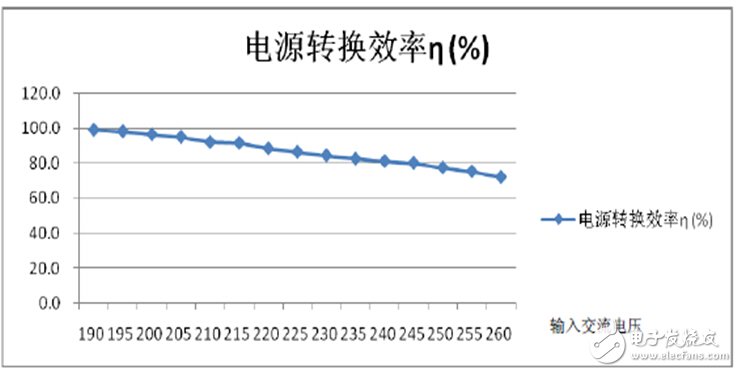
Efficiency of all linear constant current sources
While Effie's constant current source is also a linear constant current source, it adopts adaptive intelligent adjustment technology (Effie's power chip is called AICS, which is the abbreviation of “adaptive intelligent current source”). Makes its efficiency as high as 99% (see the picture below).
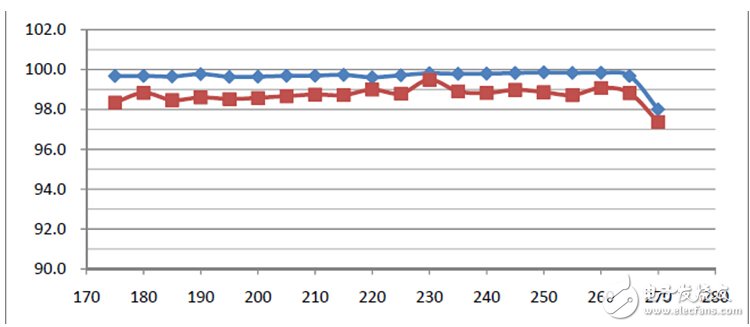
Effie's constant current source efficiency (blue line is the efficiency of the constant current source itself, red line is the total efficiency including the rectifier)
In order to remove the effects of the rectifier, Effie's light engine usually places the rectifier and all protective components on the outside of the aluminum substrate. On the aluminum substrate, there is only a constant current source with an efficiency of 99%. Therefore, its hot and cold light effect can be maintained as it is without a constant current source.
Conclusion
From here we have reached an important conclusion: only the extremely efficient constant current source can be integrated into the aluminum substrate to make the light engine, so that it will not lower the junction temperature of the LED due to the low efficiency of the constant current source. Thermal efficacy. The result of integrating the low-efficiency constant current source into the aluminum substrate is to increase the junction temperature of the LED, thereby reducing its thermal efficacy, and the difference between this cold and hot light effect is much greater than that of ordinary LED lamps. In the above example The difference is as high as 15% or more.
Therefore, we should also require all LED lamp manufacturers that use light engines to indicate the thermal efficacy on the outer packaging of the product. So as not to mislead consumers.
Envoyer à ce fournisseur

Privacy statement: Your privacy is very important to Us. Our company promises not to disclose your personal information to any external company with out your explicit permission.

Fill in more information so that we can get in touch with you faster
Privacy statement: Your privacy is very important to Us. Our company promises not to disclose your personal information to any external company with out your explicit permission.